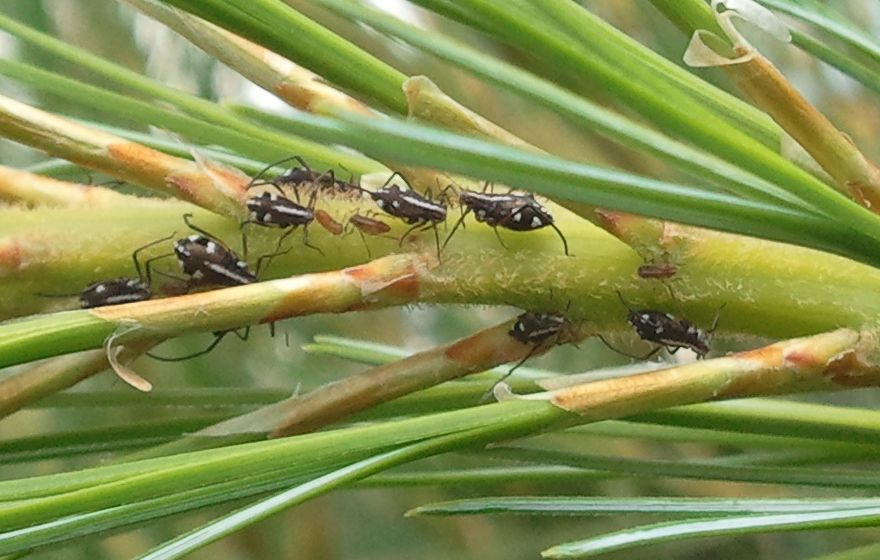Scouting for Cinara Aphids
go.ncsu.edu/readext?792148
en Español / em Português
El inglés es el idioma de control de esta página. En la medida en que haya algún conflicto entre la traducción al inglés y la traducción, el inglés prevalece.
Al hacer clic en el enlace de traducción se activa un servicio de traducción gratuito para convertir la página al español. Al igual que con cualquier traducción por Internet, la conversión no es sensible al contexto y puede que no traduzca el texto en su significado original. NC State Extension no garantiza la exactitud del texto traducido. Por favor, tenga en cuenta que algunas aplicaciones y/o servicios pueden no funcionar como se espera cuando se traducen.
Português
Inglês é o idioma de controle desta página. Na medida que haja algum conflito entre o texto original em Inglês e a tradução, o Inglês prevalece.
Ao clicar no link de tradução, um serviço gratuito de tradução será ativado para converter a página para o Português. Como em qualquer tradução pela internet, a conversão não é sensivel ao contexto e pode não ocorrer a tradução para o significado orginal. O serviço de Extensão da Carolina do Norte (NC State Extension) não garante a exatidão do texto traduzido. Por favor, observe que algumas funções ou serviços podem não funcionar como esperado após a tradução.
English
English is the controlling language of this page. To the extent there is any conflict between the English text and the translation, English controls.
Clicking on the translation link activates a free translation service to convert the page to Spanish. As with any Internet translation, the conversion is not context-sensitive and may not translate the text to its original meaning. NC State Extension does not guarantee the accuracy of the translated text. Please note that some applications and/or services may not function as expected when translated.
Collapse ▲Scientific name: Cinara species
Where from: Native to North America
Type of pest: Issue with marketing/reduces customer satisfaction
Pest description:

Cinara aphids on trunk
- On Fraser fir: Cinara aphids are large, dark aphids. They may be brown or black. They live in colonies on the trunk or branches.
- On white pine: the white pine aphids, Cinara strobe – is black with white markings and lighter colored legs. They can be found singly or in small clusters on shoots.

Cinara aphids on white pine
- Some Cinara aphids have wings.
- Cinara aphid eggs are rarely produced. They are oblong, black, and found on needles. There are typically several found in a loosely grouped together on several adjoining needles.
Damage to tree: Cinara aphids seldom damage trees. In droughty springs, terminal growth may be reduced. When present during the winter, white, crusty sap flows can sometimes be observed dripping from where aphids are feeding.
Where found in the field: Cinara aphids are found in scattered clusters of infested trees. When one infested tree is found, check surrounding trees.
Where found on the tree: Cinara aphids are typically associated with the terminal and first whorl of branches in the spring. In the fall, they are more common on the trunk or underside of branches lower in the canopy.
Scouting method:
- Cinara aphids can be found beating foliage over a plate while scouting for twig aphids.
- In the fall, do a general scout of the field. Look for hornet or yellow jacket activity in trees. Wasps are attracted to the sweet honeydew. Ants are as well. The flight pattern of hornets foraging for aphids is different than those returning to a hornet’s nest in the tree, which is more direct.
- During harvest, make sure all workers can recognize Cinara aphids and report their presence.
How weather affects: Cinara aphids are more of a problem in warm falls.
What pest can be confused with pest: Cinara aphids are often mistaken for ticks by the public. Ticks have eight legs at maturity and aphids have six.
How often should trees be scouted: Whenever working in trees, be on the lookout for Cinara aphids. Make a trip prior to harvest to look for Cinara aphids specifically.
Treatment threshold: If any Cinara aphids are found and the trees are to be harvested, they should be treated to prevent post-harvest pest problems.
Important natural enemies:
- Lady beetles and their larvae appear to be the most important natural control, though other general predators should also feed on Cinara
For more information on Cinara aphids including photographs and control recommendations, see Cinara Aphids and Other Post Harvest Pests.
For the complete Fraser fir scouting manual for western North Carolina, see Scouting Manual.


